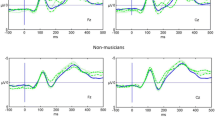Abstract
Objective
To compare the cognitive effects of guqin (the oldest Chinese instrument) music and piano music.
Methods
Behavioral and event-related potential (ERP) data in a standard two-stimulus auditory oddball task were recorded and analyzed.
Results
This study replicated the previous results of culture-familiar music effect on Chinese subjects: the greater P300 amplitude in frontal areas in a culture-familiar music environment. At the same time, the difference between guqin music and piano music was observed in N1 and later positive complex (LPC: including P300 and P500): a relatively higher participation of right anterior-temporal areas in Chinese subjects.
Conclusion
The results suggest that the special features of ERP responses to guqin music are the outcome of Chinese tonal language environments given the similarity between Guqin’s tones and Mandarin lexical tones.
摘要
目的
研究古琴(一种古老的中国乐器)和钢琴音乐对认知的影响。
方法
记录和分析了中国被试在两种音乐背景(古琴音乐, 钢琴音乐)下完成听觉 oddball 任务的行为和事件相关电位(event-related potential, ERP)数据。
结果
中国被试在本土文化的音乐环境(古琴音乐)下, 前额区诱导出更大的P300, 这一结果和已有的相关研究是相符的。同时, 不同音乐背景对ERP 产生的影响在N1和LPC(包括P300 和P500)上也表现出差别: 中国被试在古琴音乐背景下比钢琴音乐背景下表现出更多的右前侧颞叶的参与。
结论
因为古琴音乐的五声调式和汉语发音的音调具有对应关系, 因此我们推断在古琴音乐下所表现出的这种特性与被试的汉语环境有关。
Similar content being viewed by others
References
Arikan MK, Devrim M, Oran O, Inan S, Elhih M, Demiralp T. Music effects on event-related potentials of humans on the basis of cultural environment. Neurosci Lett 1999, 268: 21–24.
Balkwill LL, Thompson WF. A cross-cultural investigation of the perception of emotion in music: psychophysical and cultural cues. Music Percept 1999, 17: 43–64.
Coch D, Sanders LD, Neville HJ. An event-related potential study of selective auditory attention in children and adults. J Cogn Neurosci 2005, 17: 605–622.
Curran T, Tucker DM, Kutas M, Posner MI. Topography of the N400: brain electrical activity reflecting semantic expectancy. Electroencephalogr Clin Neurophysiol 1993, 88: 188–209.
Dalbokova D, Kolev P, Kristeva R. Selective attention in the presence of music: an event-related potentials (ERP) study. Biol Psychol 1988, 26: 307–319.
Demorest SM, Morrison SJ. Exploring the influence of cultural familiarity and expertise on neurological responses to music. Ann N Y Acad Sci 2003, 999: 112–117.
Drake C, Ben El Heni J. Synchronizing with music: intercultural differences. Ann N Y Acad Sci 2003, 999: 429–437.
Drake C, Bertrand D. The quest for universals in temporal processing in music. Ann N Y Acad Sci 2001, 930: 17–27.
Finnigan S, Humphreys MS, Dennis S, Geffen G. ERP ‘old/new’ effects: memory strength and decisional factor(s). Neuropsychologia 2002, 40: 2288–2304.
Genc BO, Genc E, Tastekin G, Iihan N. Musicogenic epilepsy with ictal single photon emission computed tomography (SPECT): could these cases contribute to our knowledge of music processing? Eur J Neurol 2001, 8: 191–194.
Juottonen K, Revonsuo A, Lang H. Dissimilar age influences on two ERP waveforms (LPC and N400) reflecting semantic context effect. Brain Res Cogn Brain Res 1996, 4: 99–107.
Karayanidis F, Andrews S, Ward PB, McConaghy N. Effects of inter-item lag on word repetition: an event-related potential study. Psychophysiology 1991, 28: 307–318.
Karniski W, Vanderploeg R, Lease L. “Virtual N400” and slow wave topography to auditory sentence incongruence. Brain Lang 1993, 44: 58–79.
Morrison SJ, Demorest SM, Aylward EH, Cramer SC, Maravilla KR. FMRI investigation of cross-cultural music comprehension. Neuroimage 2003, 20: 378–384.
Nan Y, Knösche TR, Friederici AD. The perception of musical phrase structure: a cross-cultural ERP study. Brain Res 2006, 1094: 179–191.
Neuhaus C. Perceiving musical scale structures. A cross-cultural event-related brain potentials study. Ann N Y Acad Sci 2003, 999: 184–188.
Patel SH, Azzam PN. Characterization of N200 and P300: selected studies of the Event-Related Potential. Int J Med Sci 2005, 2: 147–154.
Smith LD, Williams RN. Children’s artistic responses to musical intervals. Am J Psychol 1999, 112: 383–410.
Author information
Authors and Affiliations
Corresponding author
Rights and permissions
About this article
Cite this article
Zhu, WN., Zhang, JJ., Liu, HW. et al. Differential cognitive responses to guqin music and piano music in Chinese subjects: an event-related potential study. Neurosci. Bull. 24, 21–28 (2008). https://doi.org/10.1007/s12264-008-0928-2
Received:
Published:
Issue Date:
DOI: https://doi.org/10.1007/s12264-008-0928-2




